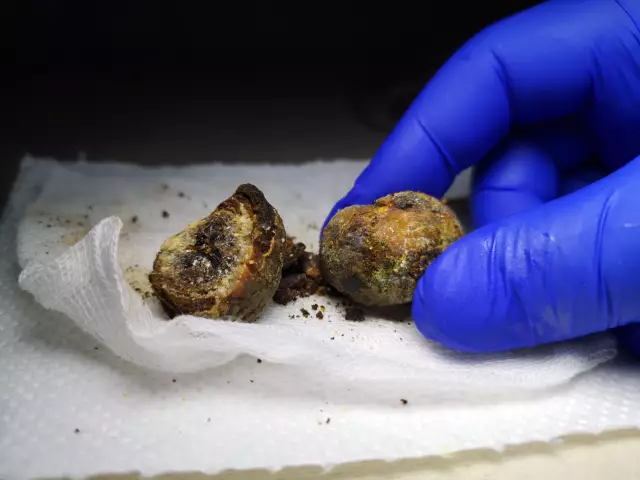- Author Curtis Blomfield [email protected].
- Public 2023-12-16 20:44.
- Last modified 2025-01-23 17:01.
In nature, everything is reasonable, and she created man as he is, not by chance. So, a child is born still not at all strong and needs careful attitude and care. And it is precisely because of this that he is able to be born unscathed: the compliance of his small body, and in particular the shape of a tiny head, ensures the most comfortable movement through the birth canal.
In this natural process, the baby is helped by special formations on the head - the so-called fontanelles. What are they and why were they conceived by Mother Nature?
Definition
The fontanel in a newborn is a non-ossified section of the cranial vault that connects its bones. Unlike an adult, in which the head is a single structure, in infants the bones are fenced off from each other and connected by movable sutures, and fontanelles are formed at their junctions. In their area, the baby's brain is covered only by its shells, a membrane of connective tissue and directly by the skin.
Ownthey got their name due to their similarity to a source of water that breaks out of the bowels of the earth: similarly, this island of life in a child is a connection with the outside world, through which the baby can report possible problems and concerns.
Types of fontanel

A newborn baby typically has six unossified zones.
Which and where is the fontanel in a newborn?
- The front, or large, is located at the junction of the parietal and frontal bones of the skull, about 2 cm in size.
- The back, or small, fontanel in a newborn is found at the junction of the parietal and occipital bones, approximately 1.5 cm in size.
- Lateral: a pair of wedge-shaped and a pair of mastoid. They are located on both sides of the head between the temporal, frontal, sphenoid and parietal bones.
What is their importance
Thanks to the fontanelles in newborns, the bones of the brain section are mobile, which is very important during childbirth. When the baby is ready to be born, in the process of opening the cervix, the baby's head changes its shape and size somewhat due to the displacement of the bones of the skull. This ensures optimal passage through the birth canal.

And after birth, the fontanel area allows the brain to grow and develop freely.
In addition to facilitating the process of labor, these non-ossified areas are needed as:
- natural shock absorber in case of fall or impacthead, which is not uncommon, since the baby has not yet developed a sense of self-preservation, and therefore nature itself has taken care of protecting the crumbs;
- thermostat - to release excess heat (the mechanism for controlling heat in infants is still imperfect, and it takes some time to adapt to the world outside the mother's womb);
- and also to diagnose possible brain problems using ultrasound, which has become the norm in medical practice in recent times.
What should be the fontanel of a newborn

The anterior non-ossified area resembles a rhombus figure, and its dimensions, according to average indicators, vary from 25 to 30 mm. During the very first month of life, it may increase somewhat, due to a change in the shape of the skull itself after childbirth and subsequent growth of the brain. Starting from approximately four months of age, the process of reducing the shape of the fontanel in a newborn begins.
The back uncured area resembles a triangle and is much smaller than the front - usually no more than 7mm.
The size of the wedge-shaped and mastoid fontanelles is small - 6-10 mm, they also have a trigonal appearance.
What determines the norm of fontanelles in newborns?
First of all, the regulation of calcium-phosphorus metabolism in the baby's body plays a huge role, which, in turn, is determined by the nutrition of the woman herself at the stage of pregnancy. So, excess of calcium and, as a result, probable early ossificationbones of the skull leads to a complication of passage through the birth canal.
Also, the size of this area in newborns also depends on the degree of full-term maturity: in babies born at term, the fontanel, as a rule, is smaller, unlike immature babies.
In the future, its value is subject to such factors as the age and characteristics of the metabolic process in the child's body, as well as the presence of any diseases (neurological or metabolic).
Convexity and hollowness as developmental anomalies
In themselves, these phenomena are not yet a pathology, since they may be due to the anatomical structure of the brain or other factors. Here it is important to understand the nature and severity: an abnormally sunken or protruding pulsating area should alert, especially if these symptoms are accompanied by fever, convulsions, etc.
What circumstances can provoke such deviations?

1. The size of a large fontanel in a newborn may exceed the limits of the norm and bulge above the surface:
- for prematurity;
- due to disruption of bone formation;
- be the result of excess fluid accumulation in brain regions.
If the baby has a progressive growth of the fontanel, accompanied by a divergence of the sutures of the skull, this is a reason for an early consultation with a neurologist.
2. Or the fontanel in a newborn may sink, be sunken. itusually observed:
- in postterm babies;
- due to insufficient fluid in the body.
Be aware that this condition can be dangerous for your baby and you should seek specialized help.
Fannel pulsation
It is an absolutely natural phenomenon in terms of anatomy: the baby's heart contracts and transmits vibrations of the cerebrospinal fluid that passes through the membranes of the brain, and since the coating of this non-ossified area is relatively thin, if you lightly touch it, you can feel how it pulsates fontanel in a newborn. This is similar to the pulsation of the carotid artery in an adult.

Her character changes every month of the baby's life:
- at the very beginning it is quite explicit;
- becomes less noticeable by about 4 months;
- at 6 months, the pulsation is still distinguishable and obligatory, but already becoming more calm, even.
Parents should remember that any change in behavior, be it crying and tears of pain or cries of joy, affects the nature of the pulsation of the fontanel in the direction of increased rhythm.
Dangerous symptoms associated with pulsation
What can be considered an unhe althy pulsation of the fontanel in a newborn and a reason for excitement?
The following main, but not an absolute list of features can be distinguished:
- speedy rhythm, especially associated with the bulge of the fontanel in a baby, as a rule,indicates increased intracranial pressure;
- intermittent, frequent rhythm changes may be a symptom of cardiovascular disease;
- lack of pulsation, especially associated with retraction of the fontanelle, is a signal of beginning or progressive dehydration of the body.
Growing time
A large fontanel in a newborn, as a rule, drags on to a year old, but sometimes there may be some deviations from this indicator in the direction of increasing the overgrowth period - up to one and a half years. This should not cause concern on the part of parents if other parameters of he alth assessment are normal.

Nevertheless, there are certain standards that reflect adequate timing for closing the "window" by months of baby's development. Below is an indicative table of sizes for trimesters with a progression of fontanel reduction.
| Child Development Period | Fannel size |
| 3 to 6 months | 21-18mm |
| 6 to 9 months | 16-14mm |
| 9 to 12 months | 12-9mm |
And a small fontanel in a newborn, as a rule, is already closed by the time the child comes into this world. But there are cases when its tightening takes place within two to three months after birth. This is also the norm, again with adequateindicators for other parameters of the baby's he alth.
What determines the closing time of the fontanelles?
In fact, this phenomenon is individual in nature, like all other features of the development of the child, whether it is the first steps of the baby, the eruption of the first and subsequent teeth, or the development of speech.
Based on observations of he althy children, the following data on the closure of the anterior fontanel were revealed:
- 1% - in three months;
- 40% - per year;
- 59% - around two years.
However, speaking about the objective factors that affect when the fontanel overgrows in a newborn, experts point to a lack of calcium with vitamin D, which can slow down the process of tightening the "breathing" islet. These elements form the basis of the solid substance of the bone and are indispensable for the intensive growth of the child's body.
At the same time, their excessive content leads to the rapid closure of the "window", due to which the baby, under certain circumstances, may experience an intracerebral hemorrhage.
As evidenced by the slow rate of fontanel closure
If the "breathable" area on the top of the head tends to stretch the hardening period, this may indicate the development of certain diseases, such as:
- rickets, as the most common;
- thyroid dysfunction;
- hydrocephalus, or accumulation of excess fluid in parts of the brain;
- genetic pathologies of various origins (glass man syndrome, Down syndrome, others).
Possible reasons for its early closure
Sometimes the time when the fontanel in a newborn overgrows comes a little earlier than the due date, at 7-10 months, which is not a pathology in an absolutely normally developing child.

But first, it is worth excluding possible diseases:
- craniosynostosis - a rare disease of the child's skeletal system, characterized by deformity of the cerebral part of the skull;
- microcephaly - poor development of the brain relative to the rest of the body.
Careful attitude
This tiny area does not require special care, and do not be afraid to touch it while washing the baby's head or combing. With a simple light touch, the structure of the fontanel cannot be damaged in any way: it is a rather dense formation, despite the fact that it looks easily vulnerable and fragile.
A light, gentle massage with a special baby brush is also useful, as it activates blood circulation and hair growth.






